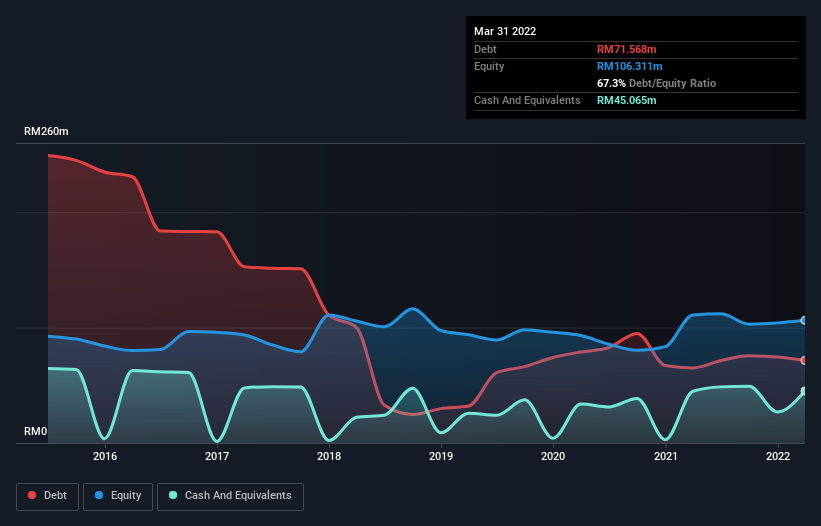Sinmah Capital Berhad (KLSE:SMCAP) Seems To Use Debt Quite Sensibly

Some say volatility, rather than debt, is the best way to think about risk as an investor, but Warren Buffett famously said that 'Volatility is far from synonymous with risk.' So it might be obvious that you need to consider debt, when you think about how risky any given stock is, because too much debt can sink a company. We note that Sinmah Capital Berhad (KLSE:SMCAP) does have debt on its balance sheet. But the real question is whether this debt is making the company risky.
When Is Debt Dangerous?
Generally speaking, debt only becomes a real problem when a company can't easily pay it off, either by raising capital or with its own cash flow. If things get really bad, the lenders can take control of the business. However, a more common (but still painful) scenario is that it has to raise new equity capital at a low price, thus permanently diluting shareholders. Of course, the upside of debt is that it often represents cheap capital, especially when it replaces dilution in a company with the ability to reinvest at high rates of return. When we examine debt levels, we first consider both cash and debt levels, together.
Check out our latest analysis for Sinmah Capital Berhad
What Is Sinmah Capital Berhad's Net Debt?
You can click the graphic below for the historical numbers, but it shows that as of March 2022 Sinmah Capital Berhad had RM71.6m of debt, an increase on RM65.1m, over one year. However, because it has a cash reserve of RM45.1m, its net debt is less, at about RM26.5m.

How Strong Is Sinmah Capital Berhad's Balance Sheet?
According to the last reported balance sheet, Sinmah Capital Berhad had liabilities of RM64.9m due within 12 months, and liabilities of RM21.6m due beyond 12 months. Offsetting this, it had RM45.1m in cash and RM59.9m in receivables that were due within 12 months. So it can boast RM18.4m more liquid assets than total liabilities.
This excess liquidity is a great indication that Sinmah Capital Berhad's balance sheet is almost as strong as Fort Knox. With this in mind one could posit that its balance sheet means the company is able to handle some adversity.
In order to size up a company's debt relative to its earnings, we calculate its net debt divided by its earnings before interest, tax, depreciation, and amortization (EBITDA) and its earnings before interest and tax (EBIT) divided by its interest expense (its interest cover). Thus we consider debt relative to earnings both with and without depreciation and amortization expenses.
While we wouldn't worry about Sinmah Capital Berhad's net debt to EBITDA ratio of 2.7, we think its super-low interest cover of 0.99 times is a sign of high leverage. So shareholders should probably be aware that interest expenses appear to have really impacted the business lately. However, the silver lining was that Sinmah Capital Berhad achieved a positive EBIT of RM9.0m in the last twelve months, an improvement on the prior year's loss. There's no doubt that we learn most about debt from the balance sheet. But you can't view debt in total isolation; since Sinmah Capital Berhad will need earnings to service that debt. So if you're keen to discover more about its earnings, it might be worth checking out this graph of its long term earnings trend.
Finally, a business needs free cash flow to pay off debt; accounting profits just don't cut it. So it's worth checking how much of the earnings before interest and tax (EBIT) is backed by free cash flow. Over the last year, Sinmah Capital Berhad saw substantial negative free cash flow, in total. While that may be a result of expenditure for growth, it does make the debt far more risky.
Our View
Sinmah Capital Berhad's conversion of EBIT to free cash flow was a real negative on this analysis, as was its interest cover. But its level of total liabilities was significantly redeeming. When we consider all the factors mentioned above, we do feel a bit cautious about Sinmah Capital Berhad's use of debt. While we appreciate debt can enhance returns on equity, we'd suggest that shareholders keep close watch on its debt levels, lest they increase. When analysing debt levels, the balance sheet is the obvious place to start. But ultimately, every company can contain risks that exist outside of the balance sheet. To that end, you should learn about the 4 warning signs we've spotted with Sinmah Capital Berhad (including 2 which are concerning) .
If you're interested in investing in businesses that can grow profits without the burden of debt, then check out this free list of growing businesses that have net cash on the balance sheet.
New: Manage All Your Stock Portfolios in One Place
We've created the ultimate portfolio companion for stock investors, and it's free.
• Connect an unlimited number of Portfolios and see your total in one currency
• Be alerted to new Warning Signs or Risks via email or mobile
• Track the Fair Value of your stocks
Have feedback on this article? Concerned about the content? Get in touch with us directly. Alternatively, email editorial-team (at) simplywallst.com.
This article by Simply Wall St is general in nature. We provide commentary based on historical data and analyst forecasts only using an unbiased methodology and our articles are not intended to be financial advice. It does not constitute a recommendation to buy or sell any stock, and does not take account of your objectives, or your financial situation. We aim to bring you long-term focused analysis driven by fundamental data. Note that our analysis may not factor in the latest price-sensitive company announcements or qualitative material. Simply Wall St has no position in any stocks mentioned.
About KLSE:SMCAP
Sinmah Capital Berhad
An investment holding company, engages in the property development business in Malaysia.
Flawless balance sheet slight.
Market Insights
Community Narratives


